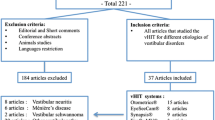Abstract
To evaluate the role of video head impulse test in the diagnosis of peripheral vestibular disorders, we performed an observational study in the outpatient department in a tertiary setup in which the clinical head impulse test and the video head impulse test were performed on 45 patients with clinically suspected peripheral vestibular disorders, and their results were correlated. To analyse our results, each ear was counted individually and hence, among 45 patients, 12 out of 90 ears showed abnormal clinical head impulse test for lateral semicircular canals and 27 out of 90 ears showed abnormal video head impulse test for lateral semicircular canals. This gave us an additional diagnostic accuracy of 21.1% on using video head impulse test for the lateral semicircular canals as compared to the clinical head impulse test. Video head impulse test is a physiological, quick and well tolerated test for assessing the vestibular function, and the only practical test for assessing the vertical semicircular canal function. Video head impulse test provides valuable information in localising the site of lesion as it assesses the semicircular canals individually. Video head impulse is merely not an objectification and registration system for the clinical head impulse test as it provides additional information such as vestibulo–ocular reflex gain, and occurrence of covert refixation saccades which cannot be picked up by naked eyes.



Similar content being viewed by others
References
Halmagyi GM, Curthoys IS (1988) A clinical sign of canal paresis. Arch Neurol 45(7):737–739
Hullar TE, Minor LB (2010) Glasscock-shambaugh surgery of the ear. In: Vestibular physiology and disorders of the labyrinth. PMPH-USA, Raleigh, pp 83–102
MacDougall HG, Weber KP, McGarvie LA, Halmagyi GM, Curthoys IS (2009) The video head impulse test diagnostic accuracy in peripheral vestibulopathy. Neurology 73(14):1134–1141
Pérez-Fernández N, Gallegos-Constantino V, Barona-Lleo L, Manrique-Huarte R (2012) Clinical and video-assisted examination of the vestibulo–ocular reflex: a comparative study. Acta Otorrinolaringol 63(6):429–435 (English Edition)
Acknowledgements
We thank Apollo Hospitals, Chennai for using hospital records and facilities in preparing this manuscript.
Author information
Authors and Affiliations
Corresponding author
Ethics declarations
Conflict of interest
The authors declare that they have no conflict of interest.
Ethical Approval
The study was performed from October 2015 to October 2016 after clearance from the ethical committee of Apollo Hospitals, Chennai.
Rights and permissions
About this article
Cite this article
Chawla, A., Abdurahiman, R. & Chokkalingam, V. The Video Head Impulse Test: Our Experience in 45 Cases. Indian J Otolaryngol Head Neck Surg 70, 498–504 (2018). https://doi.org/10.1007/s12070-018-1487-0
Received:
Accepted:
Published:
Issue Date:
DOI: https://doi.org/10.1007/s12070-018-1487-0




